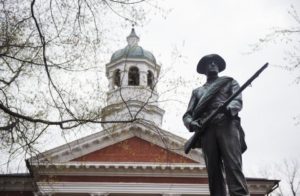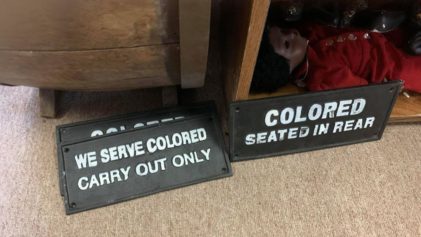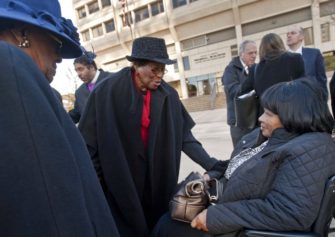LEESBURG, Va. (AP) — Gertrude Evans, 70, was born into the Jim Crow South and lived through the rocky integration of Leesburg when firemen filled a swimming pool with cement and garbage rather than permit its integration.
More than a half-century later, she turned to art as therapy to work through that traumatic period when she wasn’t allowed to sit on the red stools at Little John’s drugstore or watch a movie at the neighborhood Tally Ho theater.
The white nationalist rally in Charlottesville last year brought “everything to the surface,” she told Capital News Service recently. “. I mean you see (racism), you see it.”

“It causes conversation — good.” But “take it down and put it in Ball’s Bluff (Battlefield), you’ll never see it again,” she said. History will be forgotten.
Leesburg’s statue, like so many others around the country, became the subject of renewed concern following the 2015 murder of nine black church members by a white supremacist who posed on social media with a Confederate flag. One member of the Loudoun County Board of Supervisors has recommended the statue be moved to Ball’s Bluff Battlefield two and a half miles away where the Confederacy defeated the Union.
Virginia law prevents the county from moving or relocating the monument. In September 2017, the Loudoun County Board of Supervisors decided not to ask the state for authority to move the statue, but it asked the county’s heritage commission to make recommendations this summer regarding the statue and its surroundings.
Capital News Service recently interviewed community members in Leesburg as part of a series exploring the views of African-American and white residents in five southern cities where Confederate statues stand on public land in front of courthouses.
Teams of reporters traveled to Anderson, South Carolina; Easton, Maryland; Elizabeth City, North Carolina; Franklin, Tennessee; and Leesburg, Virginia. They also interviewed leaders of the Maryland Division of the Sons of Confederate Veterans.
Most residents, black and white, were wary of taking dramatic steps, such as removing the statues, that would inflame tensions within their communities and could make it more difficult for future generations to understand the Civil War and segregationist Jim Crow eras. Most residents also said they preferred adding more context to Civil War memorials than removing them all together.
Derek Summers Jr., 36, and the founder of Loudoun County’s Citizens’ Committee against Domestic Violence, said he feels the Confederate statue’s gun pointing at him when he drives or walks past it on North King Street nearly every day.
“It’s like letting you know that in the hearts and mind of some of these folk here, the fight’s not over,” said Summers, seated on a bench next to the statue.
David Dixon, 59, owner of Jackson’s Barber Shop a few blocks down the road, has passed the statue on his commute to Leesburg for 24 years. He said the monument doesn’t bother him.
“My personality and the way I am, I really don’t care,” he said.” I look more toward the future than the past.”
Marquez Mitchell has passed the Leesburg statue when he visits Jackson’s for a haircut every few weeks. Confederate monuments “represent hatred and slavery, even though on paper they said we were free,” the Harpers Ferry resident said.
As a child, 41-year-old Chris Johnson would go to concerts near the courtyard of the statue. Johnson, a lifelong Leesburg resident, said the statue doesn’t bother him, but “what it stands for” does.
“They don’t need to destroy it necessarily, because there are people who find value in it. But I think for the greater good it is something that should be moved,” Johnson said.
Jim Roberts who leads a walking tour to commemorate African-American history here leaves the statue off his itinerary. As a child, Roberts played near the statue and never paid much attention to it. He believes the newcomers are offended by it, not so much the old-timers.
“I can’t waste time thinking about what happened 150 years ago because it’s over and done with,” he said.
Horace Nelson Lassiter, 84, a barber at Robinson’s Barbershop which opened in 1962 said the statue “doesn’t bother me. I don’t care what is already done,” he said.
Lassiter was one of the first black police officers in the Loudoun County Deputy Sheriff’s Department in the 1960’s, and took the position “to show black people that they could get a job.”
“There’s still racism (in Leesburg). It hasn’t changed … It’s not the younger people, it’s the older people in my age group,” Lassiter said.
Lassiter’s wife, Mary Louise Lassiter, 81, a prominent activist in Loudoun County and
former local NAACP chapter president wants the statue to stay and for visitors to understand the pain slaves went through on courthouse grounds.
“When they’re told, hopefully they’ll understand the torture of all of those people who were put in those stocks.”
Formerly A Slave Market, Now a Favorite Lunch Spot
The square where the statue sits operated as a slave market throughout of the Civil War. Today the statue is surrounded by restaurants, coffee shops, a bar and the original courthouse. Government employees often lunch feet away from where whipping posts, cages and auction blocks once stood.
While the slave auctions in Leesburg were much smaller than those in other Virginia towns, the courthouse was the epicenter of the city’s slavery institution. In 1856, the court ordered that whippings move off courthouse property, according to newspaper advertisements at the time.
Three lynchings of black men accused of crimes also took place in Leesburg, in 1880, 1889 and 1902, according to the “Lynching in Virginia” history project at George Mason University.
Six years later, in 1908, the United Daughters of the Confederacy’s Leesburg chapter paid to have the statue erected to commemorate soldiers who had died in the war. Like most
Confederate statues across the South, the Leesburg statue’s unveiling came during “a terrible period of disenfranchisement — the Jim Crow period where enforced segregation and disenfranchisement really started to bleed,” said Jim Hall, author of the “Last Lynching in Northern Virginia.”
The president of the Leesburg chapter of the United Daughters of the Confederacy declined to comment, but the national organization has said it does not support racism, white supremacy or the white nationalists who rallied in Charlottesville, and that it opposes their use of Confederate symbols. Many of its members say the Civil War was not about preserving slavery, a view historians dispute.
“The statues that celebrate the Confederacy were put up when African-Americans were demanding to be treated like human beings,” Loudoun County Board of Supervisors Chair said Phyllis Randall, the only member of the board to vote in favor of asking the state for authority over the statue.
Known as “Loudoun’s silent sentinel,” the bronze figure built by famed sculptor Frederick William Sievers is a soldier with his gun cocked and his eyes fixed forward. It stands higher than both the Korean War monument to the right of the courthouse entrance and the Revolutionary War monument to the left.
In 2005, the local United Daughters of the Confederacy chapter organized the cleaning and rededication of the statue.
It was cleaned with ground up walnut shells to help dissolve the mint green oxidation covering it.
Statue Oversees Businesses District
The generic soldier has an unobstructed view of the Downtown Saloon, a biker bar established in the 1960’s and decorated in bras and Confederate symbols. The menus have images of the courthouse and statue on them. The bar sells T-shirts with art of the statue. Sometimes, motorcycle riding members of the Mechanized Cavalry of the Sons of Confederate Veterans visit and park outside.
A sticker on the mirror behind the bar says “Dixie Rider,” overlayed on top of a Confederate flag.
Scott Warner, in a black T-shirt with a Confederate flag on the left pocket, said of the statue: “Any soldier who dies for what he believes in needs to be honored.” The statue’s fate has “become a political issue and it shouldn’t be,” he said. “It’s our history.”
Not many people paid attention to the statue “until Charlottesville,” said 46-year-old Jim Boyce, seated in the restaurant. “You can’t get rid of everything,” he said. “If you get rid of everything, the history isn’t here.”
Margaret Brown, a member of the Black History Committee at the local Thomas Balch Library, protested against the statue last summer after the march in Charlottesville. She said the biker bar was an intimidating presence for protestors.
“There were some guys who were across the bar who were pretty aggressive with their motorcycles,” revving the engines and glaring at the protestors, she said.
Phillip Thompson, president of the Loudoun County NAACP, said the statue shouldn’t be located in a place for justice.
“The courthouse is a seat of power and people were trying to send a message to black citizens,” he said.
Pastor Michelle Thomas, a member of the nine-person commission assessing the future of the statue, said the statue “has the microphone — of hate and oppression and fear.”
Evans, though, has mixed feelings. The statue controversy has made her want to know more about the Civil War era.
“I know my ancestors were enslaved. But I don’t know how they were treated,” she said. “It just makes me think and wonder. I’m very interested in that whole era.”
CNS staff writers Ariel Guillory and Elisee Browchuk contributed to this report.


